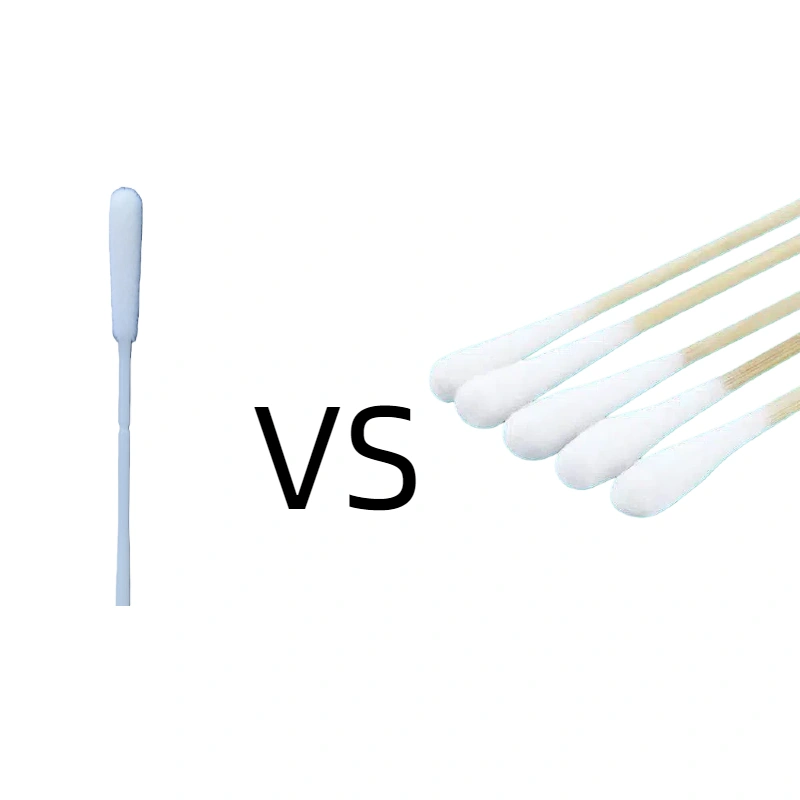The difference between flocked swabs and cotton swabs
The difference between flocked swabs and cotton swabs
In Brief:
Flocked swabs are precision tools designed for collecting and releasing samples, commonly used in medical testing.
Cotton swabs are primarily designed as everyday tools for cleaning, applying, or absorbing fluids.
Below is a detailed comparison based on several key dimensions:

Key Difference Comparison Table
Features Flocked Swabs Cotton Swabs (Twist-On)
Brush Head Material and Structure: Nylon fibers, electrostatically flocked, are attached to the handle like a brush. Cotton wool is wrapped around the handle using a twist-on method.
Sample Collection Efficiency: High. The unique “brush” structure effectively scrapes and captures more cell samples (not just fluids). Low. Primarily absorbs fluids, but cell capture is low.
Sample Release Efficiency: Extremely high (>90%). Capillary action between fibers allows for rapid and complete sample release into the storage solution or test card. Low (approximately 20-30%). The sample is trapped within the cotton fibers, making complete release difficult, resulting in sample residue. Adsorption of proteins/antigens: Low. Nylon has weak adsorption to proteins and antigens, ensuring more active ingredients enter the test. Cotton fibers adsorb proteins and antigens, reducing the amount of active ingredients available for testing.
Inhibitors: Typically not. Will not interfere with subsequent PCR or antigen testing. May contain. Cotton processing may contain or introduce chemicals that inhibit PCR reactions.
Main Applications: Medical diagnostics: Such as COVID-19 antigen/nucleic acid testing, influenza testing, sampling for other pathogens, and genetic testing. Daily cleaning/care: Such as wound disinfection, makeup removal, and electronic device cleaning.
Handle Material: Typically plastic or breakable plastic for easy insertion into sample tubes. Typically made of wood or paper.
Detailed Explanation and Impact
- Sample Collection and Release: Why use a flocked swab for testing?
A flocked swab works like a “small brush” and a “small spatula.” As you rotate it to wipe the nose or throat, the upright fibers effectively scrape cells from the mucosal surface. After collection, when the swab tip is immersed in the preservation solution, the liquid rapidly enters the interfiber spaces through capillary action and equally rapidly flushes out the sample (including cells and viral particles), resulting in highly efficient release. This means that nearly all of the sample collected can be used for further testing, improving test sensitivity.
Cotton swabs: They work like a “sponge.” Cotton fibers are tightly entangled, absorbing a large amount of mucus and fluids, but are less able to capture cells. When placed in the preservation solution, the sample becomes trapped deep within the cotton mass, making it difficult to fully release it, no matter how much you stir or squeeze it. This results in much of the sample being wasted on the swab, rather than entering the test solution, potentially leading to false negatives (infection that goes undetected).
- Impact on Test Results
Using flocked swabs: They ensure that the maximum amount of target pathogens is collected and released into the testing system, resulting in more accurate and reliable results.
Using cotton swabs: Due to their lower sample collection and release efficiency and the potential for PCR inhibitors, they can significantly reduce test sensitivity and increase the risk of false negatives.
Conclusion
When conducting any type of medical test (such as home antigen testing or nucleic acid testing), you must use the provided flocked swab. Ordinary cotton swabs should never be used as a substitute.
Flocked swabs = testing-specific tools
Cotton swabs = daily cleaning tools
 A professional supplier of swabs
A professional supplier of swabs
